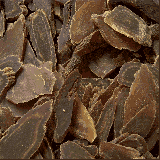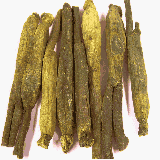| common name | Ginseng Ren Shen |
This product is the root of the perennial herb Ginseng (Panax ginseng C. A. Mey.) from the Araliaceae family. It is mainly produced in Jilin, Liaoning, and Heilongjiang. The wild variety is called "mountain ginseng"; the cultivated variety is known as "garden ginseng". It is harvested in autumn. Garden ginseng is typically cultivated for 6 to 7 years before harvest. Fresh ginseng that is washed and dried is called "sun-dried ginseng"; ginseng that is steamed and then dried is called "red ginseng"; ginseng that is scalded in water, soaked in sugar, and then dried is called "sugar ginseng" or "white ginseng"; the fine roots that are broken off during processing are called "ginseng fibers". Mountain ginseng that is sun-dried is called "sun-dried mountain ginseng". It is used sliced or ground into powder.
bubble_chart Morphological Characteristics


Sweet and slightly bitter, slightly warm. Act on heart, lung and spleen meridians.
Powerful tonification of primordial qi, banking up earth to generate metal, promoting fluid production, calming the mind.
- Used for critical symptoms and signs of qi deficiency with a faint pulse on the verge of collapse, whether caused by massive blood loss, severe vomiting and diarrhea, or prolonged illness, a large dose of Ginseng decocted and taken alone can powerfully tonify primordial qi and restore the pulse to secure collapse, such as in the case of the Single Ginseng Decoction. Recent reports suggest that the Single Ginseng Decoction can be used for heart failure and cardiogenic shock. If accompanied by reversal cold of limbs and yang qi decline, it can be combined with Aconite Lateral Root to tonify qi and restore yang, namely Ginseng and Aconite Decoction (modern preparations include Shenfu Injection); if accompanied by excessive sweating, thirst, and damage to both qi and yin, it can be combined with Ophiopogon Tuber, Schisandra Fruit to tonify qi and astringe yin, namely Pulse-Reinforcing Powder (currently available as Shengmai Injection).
- Used for lung qi deficiency with symptoms such as shortness of breath, panting, reluctance to speak, weak voice, and spontaneous sweating. Ginseng can tonify the lung and replenish qi, and can be combined with Astragalus Root, Schisandra Fruit, etc.; if panting persists for a long time and both the lung and kidney are deficient, it is often used with walnut kernel, Tokay Gecko, and other lung and kidney tonifying herbs, such as Ginseng and Walnut Decoction, Ginseng Root and Tokay Gecko Powder.
- Used for spleen qi deficiency with symptoms such as fatigue, lack of strength, poor appetite, and loose stools. Ginseng can also tonify the spleen and replenish qi, often combined with White Atractylodes Rhizome, Poria, Liquorice Root, and other qi tonifying and spleen strengthening herbs, such as Four Gentlemen Decoction.
- Used for Rebing with damage to both qi and body fluids, symptoms such as fever, thirst, and consumptive thirst, with the effect of tonifying qi and promoting fluid production. For fever with excessive sweating, thirst, and a faint pulse, it is often combined with Gypsum, Anemarrhena, etc., such as White Tiger Decoction Plus Ginseng; for consumptive thirst, it can be combined with Snakegourd Root, Unprocessed Rehmannia Root, Astragalus Root, etc.
- Used for qi and blood deficiency with symptoms such as palpitation, insomnia, and forgetfulness, with the effect of tonifying qi, calming the mind, and enhancing intelligence. It can be used alone or in combination with Unprocessed Rehmannia Root, Salvia, Sour Jujube, and other blood nourishing and spirit tranquilizing herbs, such as Celestial Emperor Heart-Tonifying Pill.
- In addition, for blood deficiency pattern, failure of qi to control blood leading to hemorrhagic syndrome, and impotence, it can tonify qi to generate blood, tonify qi to control blood, and tonify qi to tonify yang; for body deficiency with external contraction or excess pathogens with deficient healthy qi, it can be combined with exterior releasing and interior attacking herbs to reinforce healthy qi and eliminate pathogenic factors.
- Benjing: "Tonifies the five zang-organs, calms the spirit, stabilizes the soul, stops palpitations due to fright, eliminates pathogenic qi, improves vision, and opens the heart to enhance intelligence."
- 《Yongyao Faxiang》: "Ginseng is sweet and warm, capable of tonifying the original qi in the lungs; when lung qi is vigorous, the qi of the other four organs also becomes vigorous, essence naturally generates and the body naturally flourishes, as the lungs govern all qi."
- Bencao Jingshu: "Ginseng can restore yang qi from the brink of collapse and repel deficiency-type pathogens in an instant. Its main functions include tonifying the five zang-organs. Although there are five organs, in terms of the circulation of vital qi, they are one. By benefiting vital qi, all five zang-organs are tonified. The reason pathogenic qi lingers and does not leave is simply that when qi is deficient, it cannot resist, hence it lingers and does not disperse. By tonifying and making vital qi substantial, the pathogens cannot remain."
Take 5-10g in decoction; for acute and severe conditions, the dose may be increased to 15-30g as appropriate. It is advisable to decoct separately over mild fire and take with the decoction. For oral administration in powder form, take 1.5-2g each time.
bubble_chart Cautions and Contraindications
Counteracts false hellebore. Incompatible with Trogopterus Dung. Avoid consuming radishes or drinking tea simultaneously to prevent diminishing the tonic effect.
bubble_chart Modern Pharmacology
Ginseng roots contain various Ginseng saponins. The total saponin content is about 5%, which is a mixture of more than 15 saponins. It also contains a small amount of volatile oil (the low boiling point part of the oil contains β-elemene; the high boiling point part mainly contains Ginseng acetylenic alcohol), various sugars, and vitamins.
- Ginseng has an enhancing effect on both the excitation and inhibition processes of higher nervous activity. It can enhance the flexibility of nervous activity processes and improve mental labor function.
- It has an initial excitatory and then inhibitory effect on the hearts of various animals, with small amounts being excitatory and large amounts being inhibitory.
- It can stimulate the pituitary-adrenal cortex system and improve stress response capacity. It has anti-shock, anti-fatigue, blood sugar-lowering, promotion of protein RNA and DNA biosynthesis, regulation of cholesterol metabolism, promotion of hematopoietic system function, and reduction of radiation damage to the hematopoietic system.
- It can enhance the body's immune function.
- It can enhance gonadal function and has a gonadotropin-like effect.
- In addition, it also has anti-allergic, anti-diuretic, and anti-cancer effects.
bubble_chart Supplementary Medicinals
Japanese ginseng, also known as Shenlu, refers to the rhizome part at the top of the ginseng root. It is used after being steamed or soaked in sugar syrup. It has a bitter and slightly warm nature. Its functions include inducing vomiting and lifting. In the past, it was mainly used for phlegm fluid retention disease in cases of physical weakness. Recently, it has also been used to treat prolonged diarrhea and sinking of yang qi. The usual dosage is one to three qian, taken as a decoction.
bubble_chart Other Related Items




